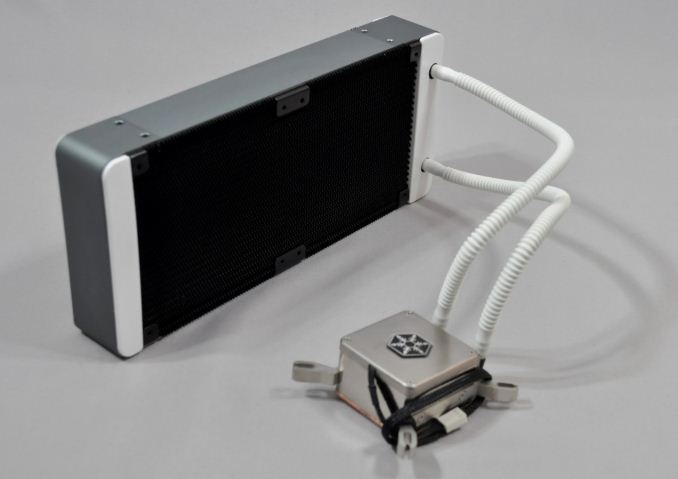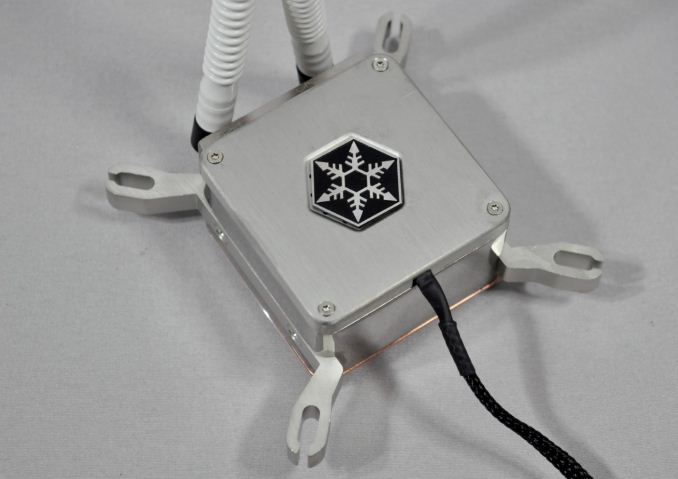Closed Loop AIO Liquid Coolers: 14-way Mega Roundup Review
by E. Fylladitakis on February 12, 2014 7:00 AM ESTSilverstone
Silverstone is another well-known name amongst advanced users and enthusiasts. The company earned their reputation from their first PSUs and original case designs and soon diversified towards cooling related products. They currently offer just two AIO liquid cooling solutions, the Tundra series. The company shipped both of them to us for this review.
Silverstone Tundra TD02
Silverstone ships the Tundra TD02 inside a large cardboard box with a black/blue theme. The box has plenty of pictures and information about the cooler printed on all of its sides. The company also supplies a fairly standard bundle with the Tundra TD02, which consists of a manual with installation instructions, mounting hardware and a syringe with thermal compound. There also is a 3-pin Y-splitter fan cable included, which can be used to power two fans off a single header. Silverstone supplies two 120mm fans with the TD02. The fans have back frames and curved, notched white blades that supposedly reduce aerodynamic noise, as well as fluid-state bearings for prolonged life. Their speed range is rather narrow, ranging from 1500 to 2500 RPM.
Visually, the Silverstone Tundra TD02 certainly stands out a lot. Although it is somewhat different, the Tundra TD02 could be coming from the same OEM that makes the Enermax Liqtech 120X as well; however, Silverstone did not want to reveal their source. The very large and deep radiator with the grey aluminum frame stands out, the size of which overwhelms any Asetek/CoolIT design. Size is not always a good thing though, as the 45mm thick design could bring serious compatibility issues, especially if the case has been designed with 27-29mm radiators in mind.
The design of the radiator is quite different from that of most other kits. Like the radiator of the Liqtech 120X, instead of wavy aluminum fins between the liquid pass-through channels, this design forms single, "seamless" fins from one side to the other, which are soldered onto the channels. The design of the fins and the overall size of the radiator though is different.
The block-pump assembly of the Tundra TD02 stands out over that of most other kits as well. It is entirely metallic, made of nickel-plated aluminum with a copper base. A badge with Silverstone's logo lies in the middle of the aluminum cap, which also has very subtle blue LEDs surrounding it. There is something unique about this block however; unlike any other assembly, including that of the Liqtech 120X, the copper base of the block is not attached to the assembly with screws, leaving the bottom of the block entirely plain. It has also been machined down to a perfect, smooth finish. The only thing that we could complain about is the use of narrow, stiff, white corrugated tubing, which is beneath the quality of such a product.
Silverstone Tundra TD03
Confusing as this may be, the Tundra TD03 actually is a smaller version of the TD02. It comes in a similarly designed cardboard box with a black/blue color theme, only it's significantly smaller. Despite the change in size however, the cooler remains very well protected within cardboard packaging and inside nylon bags. It also shares exactly the same bundle with the TD02, including the manual with the installation instructions. The two 120mm fans supplies are the same as those of the TD02, with a black frame and curved, notched white blades.
Both visually and practically, the Tundra TD03 is just a shorter version of the TD02. The radiator also shares the same design, and is just as wide and thick as the radiator of the TD02, yet nearly half as long, which means that it essentially has half the heat dissipation surface. Nevertheless, Silverstone still supplies two 120mm fans, to be used in a push-pull configuration. It is interesting to note that this radiator design appears a lot more solid, without any imperfections or bent fins, which appear to be very common on radiators with wavy aluminum fins.
As expected, the fully metallic block-pump assembly of the Tundra TD03 is identical to that of the TD02. The top and frame of the assembly are made out of nickel-plated aluminum, with the base of the block made out of solid copper. Even the mounting braces are made of solid aluminum, with those meant for Intel CPUs preinstalled on the block from the factory. Once again, the copper base is not attached to the aluminum frame with screws, at least not screws visible from the bottom of the assembly, leaving the base of the cooler perfectly clean and smooth.
























139 Comments
View All Comments
thewhat - Wednesday, February 12, 2014 - link
"the Corsair H90 ... is entirely silent when its fan's voltage is reduced down to 7 Volts."I've tried some of the quietest fans in existence and at 920 rpm they weren't even quiet, let alone entirely silent.
Anything over 600-700 rpm is usually audible, but quiet. And at around 800 rpm it stops being quiet.
Maybe we just have different standards for quietness.
But then liquid cooling was never a good option for silence freaks, anyway.
E.Fyll - Wednesday, February 12, 2014 - link
There are great differences between fans, even at same RPM, depending on their engine and wing design. This is also being displayed in this review, as fans running at nearly the same RPM have vast performance differences. At one meter away, I could not possibly discern any noise coming from the H90, that is why I classified it as silent. If however you were to install it inside a metallic case with many openings, which would reflect and enhance the noise level, you might be able to notice a low-tone humming noise - that's a maybe, a mere assumption on my part.Aikouka - Wednesday, February 12, 2014 - link
I don't know if anyone else considers it to be worthwhile, but I wouldn't mind seeing how well these coolers work when you remove one of the commonly-changed variables: the fans. I rarely ever use stock fans, and along those lines, it would be interesting to see what would happen if the same fans (per standard size -- 120mm and 140mm) were used on each cooler.jjj - Wednesday, February 12, 2014 - link
Pretty pointless without a comparison with the same fans and some air coolers.silenceisgolden - Wednesday, February 12, 2014 - link
I'm a little disappointed that patent trolls kept the Swiftech offerings from this list, but that's how things are I guess.casteve - Wednesday, February 12, 2014 - link
Thanks for the review. What was the ambient noise level and the noise meter used for the test?E.Fyll - Wednesday, February 12, 2014 - link
My apologies, I should have added this into the review. Will do so from now on. The meter is an Extech HD600 and the background noise level is 30.4 dB(A) (+/- about 0.5 dB(A), depending on the night I perform a test).casteve - Wednesday, February 12, 2014 - link
Thanks. As this meter has a lower limit of 30dB(A) and an accuracy of +/-1.4dB, your ambient is probably quieter and you are just seeing the low end of what the meter can do. Sort of expected unless (as you say) you have an expensive set up for the test equipment. Get Anand to shill out the $'s for a 10dBA microphone and an anechoic chamber for that spare bedroom. :)Some terms - if the meter is reading sound pressure level, then it's dB(A) SPL, which is referenced to 20 micro Pascals (0 dB). So, 0 dB(A) SPL is the threshold of hearing, 20-30dB(A) SPL is a calm room.
pcfxer - Wednesday, February 12, 2014 - link
All of these are way too loud. At 30+ dB, none of these coolers hit the envelope for someone who actually cares about "silence" and noise.E.Fyll - Wednesday, February 12, 2014 - link
You are confusing dB and dB(A), I am afraid. The background noise of my room at 2:00AM is 30.4 dB(A). Sub-35 dB(A) levels are generally impossible to notice by a human ear. Sub-30 dB(A) levels are next to impossible to record with anything less than science lab-grade equipment. There is no handheld or desktop dB(A) meter that can perform such readings. If you have seen reviews stating sub-30 dB(A) levels, make sure to check their methodology (given that there is any). Either the meter cannot read lower than 30 dB(A) (and/or will display a bogus reading, as most cheap Chinese meters do) and the review is a fictional text or their methodology is based on dB readings, not dB(A) readings, which is useless to a consumer.